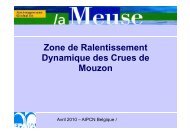PIANC E-Magazine - PIANC AIPCN welcome
PIANC E-Magazine - PIANC AIPCN welcome
PIANC E-Magazine - PIANC AIPCN welcome
Create successful ePaper yourself
Turn your PDF publications into a flip-book with our unique Google optimized e-Paper software.
None of the analysed models satisfactorily represented<br />
both the horizontal and the up-lift forces;<br />
thus, a new methodology is proposed. First, the<br />
most relevant variables of the process are studied<br />
and then the pertinent formulae are given using<br />
statistical studies and pruned neural networks.<br />
These formulae estimate the maximum horizontal<br />
force (Fh) and the up-lift force (Fv(Fh)) associated<br />
with the wave that caused Fh (Figure 7). A statistical<br />
analysis of the sliding failure mode (the most<br />
frequent failure) was conducted, which showed €<br />
that the combination (Fh, Fv(Fh)) is the most unfavourable<br />
situation in more than 70 % of the cases<br />
(Figure 8).<br />
The crown wall was considered to fail when an<br />
event larger than the resistant force occurs, no<br />
matter the duration of the event, being on the<br />
safety side.<br />
3.1. Initial Statistical Analysis<br />
The formulae that were obtained can serve to<br />
estimate the maximum horizontal force (Fh) and<br />
the maximum up-lift force corresponding to the<br />
wave that generated the maximum horizontal<br />
force (Fv(Fh)). These actions, although separated<br />
some tenths of a second, were considered to € occur<br />
at the same time on the safety side.<br />
In order to know if the design using Fh and Fv(Fh)<br />
is correct, the crown wall behaviour against sliding<br />
was studied (the most common failure in crown<br />
walls). This is:<br />
• Force data were recorded every 0.05 seconds.<br />
Hence, the failure function can be calculated for<br />
every moment in time<br />
S(t) = ( W − Fv (t))m − Fh(t)<br />
• For each test, S(t) values were ordered from<br />
greater to lower, thus obtaining the most unfavourable<br />
case of the test: the smallest S(t), from<br />
now on Sd.<br />
• On the other hand, the experimental values of<br />
Fh and Fv(Fh) were obtained for each test, and<br />
the failure function<br />
S 1<br />
= ( W − Fv (Fh))m − Fh<br />
could be calculated.<br />
Sd − S 1<br />
• Therefore, € the parameter Fh can be obtained.<br />
If Fh , then the (Fh, Fv(Fh)) es-<br />
Sd − S 1<br />
> 0<br />
timator pair is on € the security side, since<br />
S 1<br />
< Sd .<br />
€<br />
The formulation of sliding failure mode is very sensitive<br />
to the m value, a parameter that presents a<br />
great variability: Goda (1985) and the Japanese<br />
standards [BSI, 1986] suggest 0.6; ROM 0.5-2005<br />
recommends a value of 0.7, etc. For this reason,<br />
Figure 7. F h and Fv (Fh) values of the cube test; Hs = 17 cm;<br />
low crown wall = 20 cm; h = 55 cm; Ir = 4<br />
35<br />
<strong>PIANC</strong> E-<strong>Magazine</strong> n° 144, November/novembre 2011




